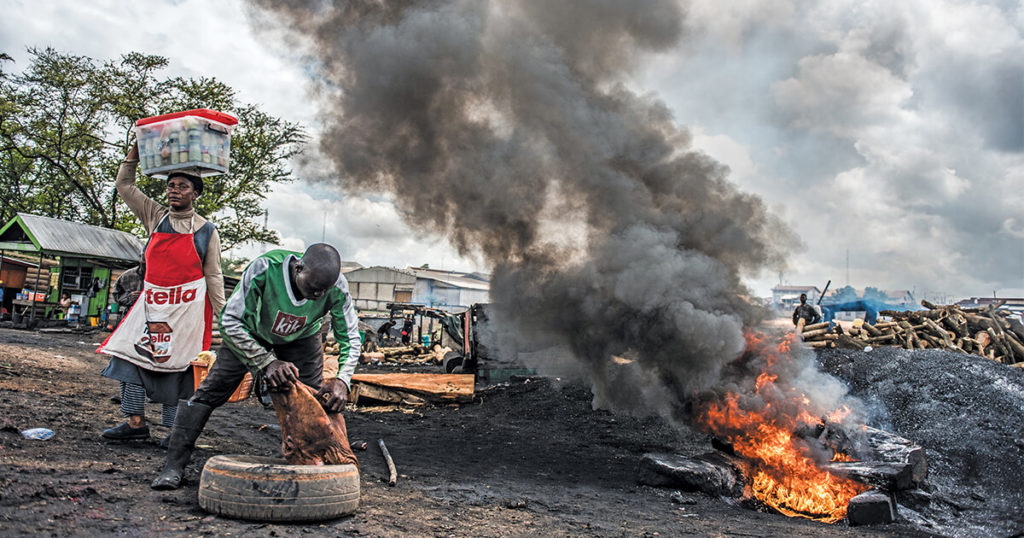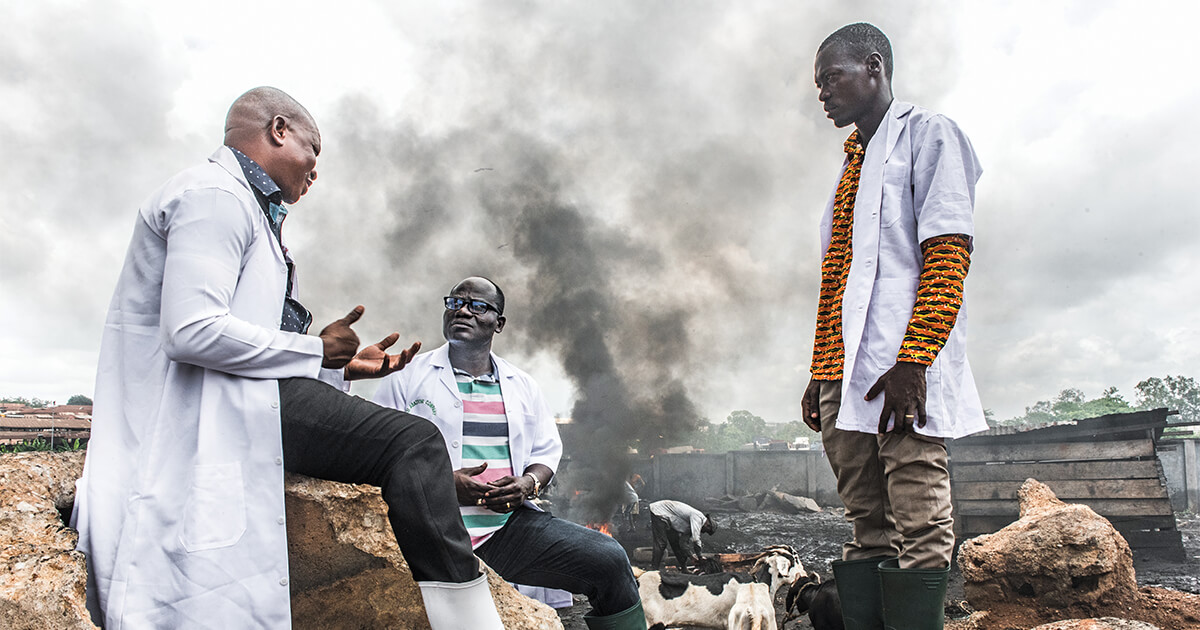Ghana: A Burning Problem
How to replace toxic scrap-tire fires with a more sustainable alternative

Evans Afriyie-Gyawu has a process. If you ever share a beer with him, he’ll open the bottle himself, ask for a plastic cup that’s not from the top or bottom of the stack, and clean the rim of the bottle with a wet wipe. Then he’ll pour some of the alcohol into the cup to semisterilize it, pour it out, refill the cup, and finally take a drink. As a toxicologist and public health expert, Afriyie-Gyawu sees contamination in places most people don’t, which makes it odd to find him surrounded by burning tires and smoldering carcasses in one of the largest meat-processing facilities in Kumasi, a city of two million people in Ghana’s Ashanti region.
It is the summer of 2018, and in the hustle of the stockyards, men yell out prices while others strain against cattle that tug and kick on their way to slaughter. Women sell homemade drinks in reused soda bottles from baskets balanced on their heads. Goats bleat as they’re led toward tall, lingering smoke columns that resist the color of the surrounding cityscape. Walking alongside them, I feel my chest tighten as the open air is choked with the iron smell of blood, burning hair, and melting rubber. The ground changes from pavement to dirt to a slurry of excrement riddled with flesh and wire while chickens peck at mounds of bones that line the path. A man rushes by with tires slung up under his arms and smiles as he dodges around a friend pushing a wheelbarrow filled with cow legs going the opposite direction.
Nearby, a severed bull head is unceremoniously snatched from the ground and tossed on top of a blazing car tire, the hair sizzling as the heat curls its lips back into a macabre grin while flames lick at its teeth. It’s singed for a time—the black chemical smoke billowing around the meat as it begins to look and smell like the tire itself—until a worker plucks it from the fire and sets it on a cart bound for market. The meat, now coated with chemical contaminants, is intended for human consumption, and that’s why Afriyie-Gyawu is here: to see how deeply the practice of cooking with tire fires is affecting public health. A Ghana native, he moved to the United States to attend college. Now a professor of epidemiology and environmental health at Georgia Southern University, he has spent the better part of a decade researching ways to improve food safety in his home country and returns there every year with a small group of students in his quest to eradicate the processing of meat with tire fires in favor of more healthful, more sustainable alternatives.
As liquefied petroleum gases (LPG) like propane, typically used for cooking, have grown more expensive, Ghanaian companies have taken advantage of lax regulation to cut costs. Often they use discarded tires, abundant and free for the taking in Kumasi, to singe animal hides and to smoke meat. But the act of burning tires on any scale emits contaminants like benzene, which can damage human bone marrow and decrease red blood cell counts; sulfur dioxide, a known respiratory irritant; and carbon monoxide, a gas that can permanently impair heart and brain functions, ultimately leading to asphyxiation and death. The list goes on—hydrogen chloride, polychlorinated biphenyls, volatile organic compounds. The dangers are clear, but even so, contaminated meat is difficult to avoid: food processed using tire fires is indistinguishable from that processed by safer means.
Of the four major meat production facilities in Kumasi, three of them use tires. At this one, which processes up to 70 cattle and 120 goats every day, Afriyie-Gyawu walks past the pit and finds Oman, the man in charge. His scarred face and bloodstained shirt stand out against Afriyie-Gyawu’s unblemished spectacles and clean lab coat. Even so, the two greet each other warmly. As they talk, Oman pauses to cough and spits up phlegm that is just as dark as the ground he walks on. Nearby, workers cover their mouths with handkerchiefs and grab meat out of the fires using scrap pieces of denim as hot mitts.
Tires make meat cheap. Although Ghana’s fragile economy has begun to strengthen in the past decade, nearly a quarter of the population continues to live below the poverty line, and many struggle with food security. In such an environment, companies like Oman’s prosper by providing meat at lower prices than facilities with higher overhead and more extensive safety protocols.
But the practice is killing people, in Ghana and throughout West Africa. Afriyie-Gyawu is here to take smoke and meat samples and determine how much of a tire’s chemicals get into meat and, ultimately, into people. This process, called bioaccumulation, occurs when harmful contaminants are built up in an organism faster than they can be excreted (think of mercury warnings with regard to tuna and other large fish). In the case of a cow carcass being roasted over a bald truck tire filled with gasoline, what is accumulated in the meat stays in the meat until it’s ultimately passed on to the consumer.
“I grew up here and never saw it,” Afriyie-Gyawu says, “but after seeing all the chemicals that are being emitted when you burn tires, there is no way that I could have turned my eyes away.”

Afriyie-Gyawu (center) discussing challenges facing Ghana’s meat-processing industry with KACL managers. Behind them, workers prepare a tire fire. (Rob G. Green and Michael O’Hara)
One meat-processing facility in Kumasi is working to stem the practice of tire fires. A hundred yards from Oman’s operation sits the Kumasi Abattoir Company, Ltd. (KACL), which has been integrating improved measures for meat inspection, handling, and processing since switching to the use of LPG in 2006. It has likewise developed screening and quarantine protocols for diseases like bovine tuberculosis, hired and trained workers to monitor and ensure quality, and adopted personal protective equipment standards for all workers and visitors to the site.
Inside the quiet front office are a plain white tile floor, plastic lawn chairs, an untended reception desk, and a small TV, on which staff members watch soccer on their breaks. Here we’re greeted by Michael Tongban, the company’s marketing manager. After working for KACL for more than 20 years, he’s clear-eyed about the challenges of trying to frame a public health issue in dollars and cents.
“To singe one goat, for example, it costs 16 cedis [$2.96 USD] with LPG, but 3 cedis [$0.55] with tires. That’s why so many of them use scrap tires,” he says. “Lesser cost.”
Touring the KACL facility, what you notice is how different it is from the nearby tire pits. Workers strictly observe wash-in and wash-out procedures. A clear chain of accountability documents each animal from the moment it’s bought by KACL to the moment it’s sold at market. Temperature is controlled. Surfaces are routinely cleaned and sanitized.
It is difficult to compete with the facilities that use scrap tires, but Tongban and KACL’s leadership make headway where they can. When a tire operation was recently forced to close because of an outbreak of bovine tuberculosis, KACL took an opportunity to expand by hiring out-of-work butchers who had previously labored in the pits.
The company has lately begun exploring ways to implement a sustainable bio-gas system that would allow it to harvest methane from the production process itself by heating animal byproducts and waste in an anaerobic underground fermenter. “Using collected methane to singe meat is cheaper than LPG gas, and potentially even cheaper than tires,” says KACL administrative manager Bugbil Benedict Zobil. If successful, the supplemental bio-gas system would allow for operations like KACL to undercut tire-pit practices on price alone, theoretically attracting consumers with a more affordable and more healthful option.
The only problem is the cost: an estimated $1.3 million. Investing in a such an expensive system puts the entire company at risk, and that’s why Afriyie-Gyawu’s work has become so crucial. By providing data that demonstrate the environmental and public health ramifications, together with cost-effective strategies to mitigate the practice of tire-fired meat processing, KACL hopes to appeal for outside funding.
“It’s a matter of having the political will to address the problem,” says Afriyie-Gyawu. “I believe they would put money into it if they understood the magnitude of the problem.”
Back at the tire pits, amid ash and debris, a butcher has led a goat to a spot upwind of the nearby fire. He rolls it on its side and slits its throat in one impressive motion while another man, barefoot and wearing a wedding ring, holds its muzzle to stabilize the animal until the flailing subsides and the carotid artery stops squirting blood into the air.
These workers do not choose to breathe toxic chemicals for hours every day. Rather, circumstance, economic conditions, and lack of education dictate that they burn tires for income—for themselves, their families, and their community. They are not criminals, but depending on the nature of new regulations, they could be.
Simply asking a government to render the practice illegal and to jail tire-fire workers is only going to keep poor families poor while spiking the cost of meat for those who rely on getting it cheaply. “Hopefully there can be an agreement between the scientific community, the community residents, the politicians, as well as the meat-singeing operators so we can bring the practice to a halt and introduce an alternative,” Afriyie-Gyawu says. “When we’re able to do that, that’s when I believe we’ll be able to effectively address this issue.”
Meat processing is part of life in Ghana. The slaughtering of animals can be graphic, even shocking, but despite how it might seem to consumers, meat does not come from a store. Oman knows where it comes from, as do Tongban and Zobil. So does Afriyie-Gyawu—a germaphobe surrounded by contaminated meat and carcinogenic tire smoke. He could be back in Georgia prepping the rim of a beer bottle, relying on someone else to deal with the problem. Instead, he is shaking hands with a butcher covered in dried goat blood and learning his name. He knows his data alone won’t make the difference, but it adds another wave to the tide of awareness now rising in Ghana.
In the year since I visited Kumasi with Afriyie-Gyawu, he has continued to work closely with KACL. Although there have been few significant changes at the federal level, Randy Afful, a spokesperson for KACL, says the bio-gas system has been almost entirely supported by the United Nations Industrial Development Organization. Although the project is still roughly $150,000 short of the necessary funding to finish its construction, the company continues to apply for financial backing and hopes to implement its bio-gas program by 2020.

